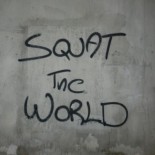Experimental Geographies
"There is tenderness only in the coarsest demand: that no-one shall go hungry any more" – Theodor Adorno, Minima Moralia (1974: 156)
Eggleston’s Everyday
“A picture is what it is and I’ve never noticed that it helps to talk about them, or answer specific questions about them, much less volunteer information in words. It wouldn’t make any sense to explain them. Kind of diminishes them. People always want to know when something was taken, where it was taken, and, God knows, why it was taken. It gets really ridiculous. I mean, they’re right there, whatever they are.”
-William Eggleston in interview with Sean O’Hagen (The Observer, July 25, 2004)
“There are no ideas but in things.”
-William Carlos Williams, Paterson
I was lucky enough to catch the new William Eggleston show at the Victoria Miro Gallery in London yesterday. While a small show of 22 photographs themselves modest in scale (22 x 28 inches), it did not disappoint. In fact, the show was a welcome respite from the tableau-format aesthetic which has come to acquire a certain orthodoxy within advanced photographic practice. The show features work produced by Eggleston over the past decade and runs concurrently with a show at Cheim & Read in New York. A large number of the photographs once again reference the American South that has featured so prominently in Eggleston’s earlier work.
All the trademark Eggleston qualities can be found here: his remarkable use of colour and often skewed points of view, the contained painterly imperatives and the seeming casualness and ordinariness of his subjects. Indeed, the very words used by John Szarkowski to describe Eggleston’s landmark 1976 show at MOMA have never seemed more accurate. For Eggleston as for many other photographers of his era (Helen Levitt, Stephen Shore, and Joel Meyerowitz), the very use of color was “existential and descriptive; these pictures are not photographs of color, any more than they are photographs of shapes, textures, objects, symbols, or events, but rather photographs of experience, as it has been ordered and clarified within the structures imposed by the camera.”
With this in mind, it would perhaps be a bit misleading to suggest that Eggleston monumentalizes the everyday (as stated in the show’s press release). I would prefer to argue that he attends modestly to the structures of visibility that attach themselves to the ordinary and everyday. The compositional clarity and luminosity so lauded by Adrian Searle in his recent review of the show seem here to invest the everyday with a justifiable depth and complexity (and with a perhaps a nod to a new found sense of pictorial abstraction).
There is a wonderful passage by the philosopher Ludwig Wittgenstein that appears in the volume Culture and Value. It is a thought experiment on the nature of aesthetics and we learn from Wittgenstein that the “the work of art compels us…to see in the right perspective.” “[…]Without art,” Wittgenstein continues, “the object is a piece of nature like any other & the fact that we may exalt it through our enthusiasm does not give anyone the right to display it to us” (Wittgenstein, 1998 [1930]: pp. 6e-7e). This passage has been seized on recently by the art historian Michael Fried in a remarkable discussion of the photography of Jeff Wall and the relationship of Wall’s work to notions of the everyday (see Fried’s 2008, Why Photography Matters as Art as Never Before). There is something to recommend in this view though I think it ultimately misses the mark and I do wonder whether Eggleston’s work is more appropriate to the terms that Wittgenstein proposes. In other words, I would suggest that his photographs really do compel us to understand the everyday as a source of deep aesthetic contemplation. Wall’s own compositions – important as they are – possess a certain artifice or staginess that owes much to the painstaking construction of the depicted setting. In the case of Eggleston, this staginess seems to emerge directly out of the everyday itself whether it is shining spoon lying on a windowsill or a faded newspaper page on the ground (this is even allegorized by Eggleston in Untitled, Room with Old TV, Lamps, Wildwood, New Jersey, 2002). In other words, I wonder whether Wall’s photographs are meant to tell us that we should see them as works of art whereas we simply know when we look at Eggleston’s photographs that they are works of art.

Tod Papageorge: “my argument against the set-up picture is that it leaves the matter of content to the IMAGINATION of the photographer, a faculty that, in my experience, is generally deficient compared to the mad swirling possibilities that our dear common world kicks up at us on a regular basis”
The first major US retrospective of Eggleston’s work has just opened at the Art Institute of Chicago. Details here:
http://www.artic.edu/aic/exhibitions/exhibition/Eggleston